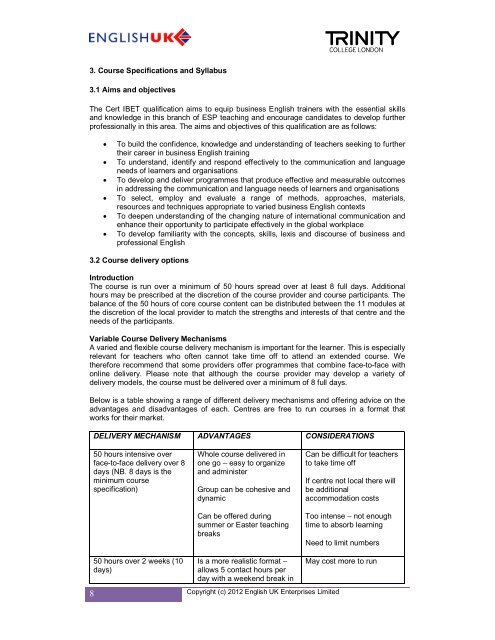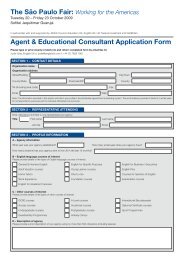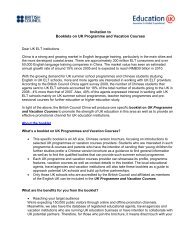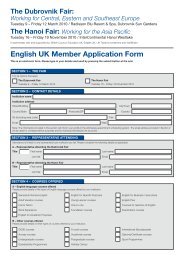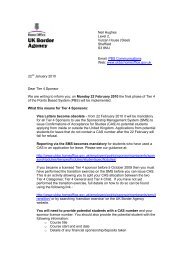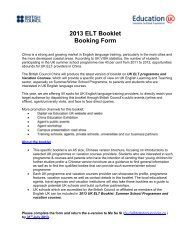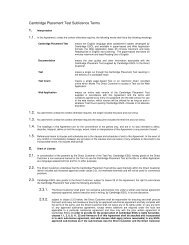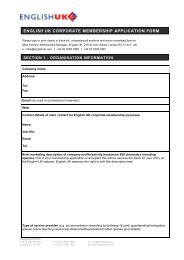cert ibet - English UK
cert ibet - English UK
cert ibet - English UK
You also want an ePaper? Increase the reach of your titles
YUMPU automatically turns print PDFs into web optimized ePapers that Google loves.
3. Course Specifications and Syllabus<br />
3.1 Aims and objectives<br />
The Cert IBET qualification aims to equip business <strong>English</strong> trainers with the essential skills<br />
and knowledge in this branch of ESP teaching and encourage candidates to develop further<br />
professionally in this area. The aims and objectives of this qualification are as follows:<br />
· To build the confidence, knowledge and understanding of teachers seeking to further<br />
their career in business <strong>English</strong> training<br />
· To understand, identify and respond effectively to the communication and language<br />
needs of learners and organisations<br />
· To develop and deliver programmes that produce effective and measurable outcomes<br />
in addressing the communication and language needs of learners and organisations<br />
· To select, employ and evaluate a range of methods, approaches, materials,<br />
resources and techniques appropriate to varied business <strong>English</strong> contexts<br />
· To deepen understanding of the changing nature of international communication and<br />
enhance their opportunity to participate effectively in the global workplace<br />
· To develop familiarity with the concepts, skills, lexis and discourse of business and<br />
professional <strong>English</strong><br />
3.2 Course delivery options<br />
Introduction<br />
The course is run over a minimum of 50 hours spread over at least 8 full days. Additional<br />
hours may be prescribed at the discretion of the course provider and course participants. The<br />
balance of the 50 hours of core course content can be distributed between the 11 modules at<br />
the discretion of the local provider to match the strengths and interests of that centre and the<br />
needs of the participants.<br />
Variable Course Delivery Mechanisms<br />
A varied and flexible course delivery mechanism is important for the learner. This is especially<br />
relevant for teachers who often cannot take time off to attend an extended course. We<br />
therefore recommend that some providers offer programmes that combine face-to-face with<br />
online delivery. Please note that although the course provider may develop a variety of<br />
delivery models, the course must be delivered over a minimum of 8 full days.<br />
Below is a table showing a range of different delivery mechanisms and offering advice on the<br />
advantages and disadvantages of each. Centres are free to run courses in a format that<br />
works for their market.<br />
DELIVERY MECHANISM ADVANTAGES CONSIDERATIONS<br />
50 hours intensive over<br />
face-to-face delivery over 8<br />
days (NB. 8 days is the<br />
minimum course<br />
specification)<br />
Whole course delivered in<br />
one go – easy to organize<br />
and administer<br />
Group can be cohesive and<br />
dynamic<br />
Can be offered during<br />
summer or Easter teaching<br />
breaks<br />
Can be difficult for teachers<br />
to take time off<br />
If centre not local there will<br />
be additional<br />
accommodation costs<br />
Too intense – not enough<br />
time to absorb learning<br />
Need to limit numbers<br />
50 hours over 2 weeks (10<br />
days)<br />
Is a more realistic format –<br />
allows 5 contact hours per<br />
day with a weekend break in<br />
8 Copyright (c) 2012 <strong>English</strong> <strong>UK</strong> Enterprises Limited<br />
May cost more to run


